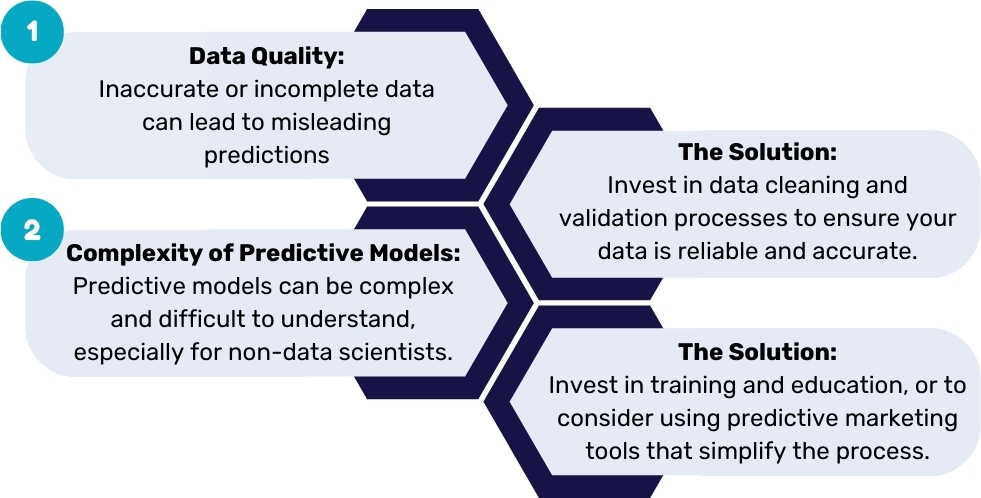
A Complete Guide to Leveraging Predictive Marketing
Author: Kysha Praciak
· 4 mins readIntroduction
Predictive marketing is a game-changer in the world of marketing. It leverages data, statistical algorithms, and machine-learning techniques to identify future outcomes based on historical data. The goal is to go beyond knowing what has happened to provide a best assessment of what will happen in the future.
As a marketer, I’ve come to realize the power of predictive marketing in identifying potential opportunities and risks in the future. It’s not about seeing the future, but rather about providing a plausible forecast that aids in strategic decision-making.
Understanding the Power of Predictive Marketing
Predictive marketing is powerful because it allows us to not only understand our customers better but also to anticipate their needs. We can identify which customers are most likely to convert, which are at risk of churning, and which are the most profitable. This insight enables us to make data-driven decisions that can significantly impact our bottom line.
The power of predictive marketing is further exemplified in personalization. In today’s competitive marketplace, personalization is key to customer retention. Predictive marketing enables us to deliver highly personalized experiences to our customers, which in turn fosters loyalty and drives revenue growth.
Moreover, predictive marketing helps us to optimize our marketing efforts. By predicting customer behavior, we can align our marketing strategies accordingly. This not only saves time and resources but also enhances the effectiveness of our marketing campaigns.
Key Benefits of Predictive Marketing
- Significantly Improve Efficiency
- With predictive analytics, we can target the right customers with the right message at the right time, thus avoiding wasted effort and resources on unresponsive leads.
- Enhance Customer Experience
- By understanding our customers’ needs and preferences, we can provide them with more relevant and personalized experiences.
- This not only increases customer satisfaction but also fosters loyalty and repeat business.
- Lead to Increased Revenue
- By identifying potential customers, anticipating their needs, and tailoring our offerings accordingly, we can drive more conversions and increase our sales.
The Role of Data in Predictive Marketing
Data is the lifeblood of predictive marketing, without data, it simply cannot exist. Data the raw material that fuels the predictive algorithms and models that underpin this approach.
The first step in leveraging data for predictive marketing is collecting it. We can gather data from various sources such as customer transactions, social media interactions, website visits, and even external data like market trends and customer demographics. The more data we have, the more accurate our predictions will be.
However, collecting data is just the beginning. The real work lies in analyzing and interpreting this data to extract meaningful insights. This is where predictive analytics comes in. Predictive analytics involves using statistical techniques to analyze current and historical data to make predictions about future events.
Need Expert IT Solutions?
Get a Free Consultation Today!
Whether you’re dealing with network issues, cybersecurity concerns, or software integration, our team of IT experts is here to help. Don’t let tech troubles slow you down. Call us now for a complimentary initial assessment, or click below to fill out our quick contact form. Let’s make technology work for you.
Steps to Implement a Predictive Marketing Strategy
- Define Your Goals
- What do you want to achieve with predictive marketing?
- This could be anything from increasing sales to improving customer retention.
- Gather and Clean Your Data
- This involves collecting data from various sources and ensuring it’s reliable and accurate.
- Data cleaning is a crucial step as inaccurate data can lead to misleading predictions.
- Start Building Your Predictive Models
- This involves selecting the appropriate statistical techniques and algorithms based on your goals and data.
- Test and Refine Your Models
- Predictive models are not set in stone.
- They need to be continuously tested and refined to ensure they remain accurate and relevant.
Predictive Marketing Tools and Software
These tools can help you collect and analyze data, build predictive models, and even automate your marketing campaigns. Some popular predictive marketing tools include Google Analytics, Marketo, and HubSpot.
- For example, Google Analytics is a powerful tool that allows you to track and analyze your website traffic. You can use this data to identify trends and patterns in customer behavior, which can inform your predictive marketing strategy.
Real-life Case Studies of Successful Predictive Marketing
There are many real-life examples of companies successfully harnessing the power of predictive marketing, for example:
- Amazon uses predictive analytics to provide personalized product recommendations to its customers. This not only enhances the customer experience but also drives increased sales.
- Netflix uses predictive algorithms to recommend shows and movies based on a user’s viewing history. This personalized approach has been instrumental in Netflix’s success, with the majority of their viewing coming from their recommendations.
Challenges and Solutions in Predictive Marketing

Future of Predictive Marketing
The future of predictive marketing is exciting. With advancements in technology and data analytics, the possibilities for predictive marketing are endless. Artificial Intelligence and Machine Learning, are poised to take predictive marketing to new heights by automating the predictive process and delivering even more accurate predictions.
In the future, I believe we’ll see predictive marketing becoming a standard practice in the business world. Companies that fail to adopt this approach may find themselves at a competitive disadvantage.
Conclusion
In conclusion, predictive marketing is a powerful tool that can drive business success. It’s not just about predicting the future, but about making informed decisions that drive growth and profitability. By harnessing the power of predictive marketing, we can deliver personalized experiences, optimize our marketing efforts, and ultimately, increase our bottom line.
Embracing predictive marketing is not an option, but a necessity in today’s data-driven world. So, if you haven’t already, it’s high time you start leveraging the power of predictive marketing to propel your business forward.
Additional Resources
Read more on Digital Marketing by visiting our blog, or see our services to discover how we can help your business!
References:
Amazon Web Services. (n.d.). What is Predictive Analytics? Retrieved from https://aws.amazon.com/what-is/predictive-analytics/
Ankleshwariya, Y. (2023, June 28). How Predictive Analytics Enhance Various Aspects [LinkedIn article]. Retrieved from https://www.linkedin.com/pulse/how-predictive-analytics-enhance-various-aspects-yash-ankleshwariya/





Share